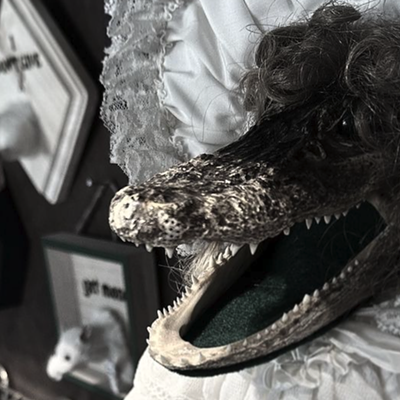The question that keeps coming up in Orson's Shadow, now playing at Gorilla Theatre, is "Why should we care?" What do these celebrated artists — Orson Welles and Laurence Olivier, Vivien Leigh, Joan Plowright and Kenneth Tynan — have to say to us about theater or film or celebrity or — least likely of all — our own lives? That art is no bed of roses? Well, we already knew that, thanks to Keats and Beethoven and Van Gogh and Charlie Parker. That even the famous have their ups and downs? Well, we have the Enquirer for that, and Star and People. So why are we watching Welles, for most of an act, trying to direct Olivier in Ionesco's Rhinoceros, with Olivier making every effort to obstruct, and Welles becoming increasingly exasperated? The problem is compounded by the fact that the actors playing Welles and Olivier don't remind us in the least of Welles and Olivier, and the impersonations that do work, of Tynan and Leigh and Plowright and the stagehand Sean, seem peripheral even when given serious stage time. Finally, there seem only two possibilities: Either there's some deeper meaning that isn't getting through, or there's just the spectacle of famous people acting ignobly, which isn't worthy of our attention. In either case, Orson's Shadow doesn't satisfy.
The story it tells would be fresh from Inside Edition if it weren't 40 years old: Great British critic Ken Tynan persuades washed-up former boy genius Orson Welles to direct Larry Olivier in Ionesco's absurdist parable. Olivier is in the process of breaking up with his manic-depressive wife Vivien Leigh and has already found a new mate in Plowright. But Olivier doesn't have any love for absurdism, and Leigh shows up and has an episode in front of everyone, and it's all very embarrassing and then it's over. And just to remind us that the stars too are mortal, we're told at the end how Olivier contracted a wasting muscular disease, and heavy smoker Tynan died of emphysema at 53, and Leigh died at the same age of tuberculosis. It's certainly tragic, and if you love life and the arts, it's just another sad reminder of what Yeats complained of, that the soul, the beautiful soul, is tied to "a dying animal." But that much would be clear if we only had the play's epilogue, which takes all of two minutes.
Of course, if all the actors in Orson's Shadow could convince us that we really were watching Welles and Company in Chaos of the Rich and Famous, we'd at least have the pleasure of celebrity voyeurism. But Jim Wicker never comes anywhere near resembling Welles, and Steve Garland is just as far, or farther, from being Olivier. Wicker's Welles isn't badly acted; it's just not Welles. Instead it's a slightly sarcastic, somewhat self-critical nice guy, and we search fruitlessly for the fat, arrogant, condescending titan who eventually ended up in those regrettable television commercials. Garland's Olivier, meanwhile, comes across as a nervous, drab, somewhat introverted intellectual and not at all the charismatic chameleon of Hamlet and Richard III. And what are we to make of the several references to Welles' girth when Wicker's tall but medium build is right in front of us, contradicting the script?
Fortunately, the four other actors fill their roles persuasively. Best of all is Emilia Sargent, who plays Vivien Leigh as a likeable, sinned-against beauty who can't help it if she's subject to episodes of mania. I've reviewed Sargent several times over the years, but I think this is her best work ever: she makes no attempt to seem a victim, which makes her victimhood even more poignant. Tim Seib as Ken Tynan is bright-eyed and idealistic, more ingenuous than one would have guessed from reading Tynan's biography but still credible and consistent. Caitlin McDonald as Joan Plowright is nothing short of superb, taking an underwritten role and giving it calm and dignity. And Andrew Hughey as opinionated stagehand Sean is no less impressive; with just a few lines he suggests a subordinate who's never subservient. Nancy Cole's directing is usually solid, though it can't solve the problem of the infelicity of the two male leads. She's helped, however, by Mike Buck and Chris Blem's costumes and by Megan Byrne's evocative lighting.
The set is another story. The script tells us that we're on the stage first of the Gaiety Theatre in Dublin, then of the Royal Court in London. In the former, we're supposed to see "furniture of a medieval tavern ... scattered across the stage," and in the latter we should see, first, just a few chairs, and later, part of the set for Rhinoceros. Well, we do see part of some set in Act 2, though I wouldn't guess it to be Rhinoceros'; but in Act 1, all designer Eric Haak gives us are some scattered chairs and tables, so that it looks like someone at Gorilla Theatre has forgotten to build a set. This may seem like a small problem, but in fact the missing set compounds our confusion with the miscast actors, and it's hard not to feel, several minutes into the play, that we've stumbled into a rehearsal, before actors have found their characters and before a set has been loaded in. This may seem a desirable confusion, given the play's subject. Believe me, it's not.
Anyway, it's a tough order: to find actors who can convince us we're seeing Welles and Olivier, to make their stories matter to us plebes in the audience, to build a set that's a set and not a set at the same moment. I'm not surprised that the current production doesn't rise to the challenge — where in the world is one supposed to find another Olivier? Still, I wish that Orson's Shadow had more to communicate than the fact that stars, too, are fallible. That much we learn every week in the supermarket checkout lane.
















